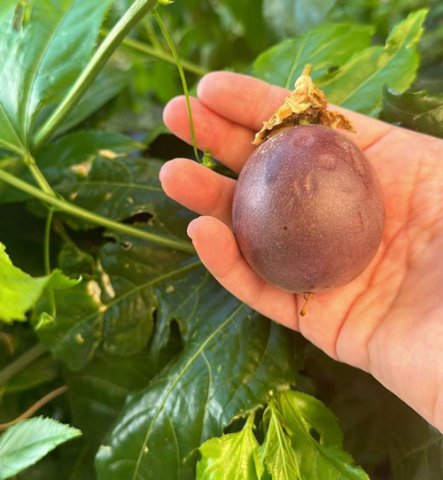I love the passion fruit! It is a tropical fruit and is not commonly found in our markets. So I decided to plant one in my garden. And as with many things, this experience was forged by trial and error.
There are many varieties and most of them grow as climbing vines. This is what I wanted to plant. I envisioned it climbing over the wooden pergola at the back of my garden. And I also planted some kiwi vines to complete the landscape. However, I had not tested the soil and didn't take into consideration sun exposure and learned that this particular spot in my garden wasn't ideal for this kind of plant. And so the first attempt failed. I was sad to see the vine bear a few fruits, but then wither and die... Still, I wanted to give the passiflora another try. I was sure it would grow in my garden. I just needed to find the appropriate location for it to feel good. And last year, a friend got me a shrub that I planted near the terrace. I didn't expect it to acclimate so well, with a small blueberry plant right next to it. But it did. So much, that it grew about 300% its original size in one year, covering the railing and expanding over the neighboring planters, even the 3-tier vertical garden!
There are 3 cultivars that are popular among gardeners:
- passiflora edulis, which produces a purple fruit on the outside that contains a lot of seeds and grows to be the size of a small lemon. This fruit is usually sweet.
- passiflora edulis flavicarpa, of which the fruit's skin is yellow and grows as big as a grapefruit. This fruit is more acidic/sour in taste.
- passiflora coccinea and passiflora incarnata can grow in cooler regions.
This vine matures between 1 to 2 years. After which, it can bear fruits. The edulis type is self-pollinating, while flavicarpa necessitates cross-pollination from another plant to produce a fruit. The pollen of their beautiful flowers is not spread by the wind and insects, such as bees or others, are needed for a successful pollination. Once pollination has occurred, you need to wait about 80 days before the fruits are ripe to be harvested. This gardener's favorite is easy to maintain:
- plenty of sun exposure, at least 6 hours per day in a moderate climate
- fertile, well-drained, humid soil: be careful to avoid overwatering
- if you want to use fertilizer, apply high-potassium liquid or slow-release granules once per season
- space to climb/grow: a metal mesh, a sturdy fence, or a pergola are ideal robust structures
- pruning can be advisable if you don't want the vine to cover any space it gets a hold on, just make sure to do it in the fall or winter, when no fruits are expected
- several pests can damage the vine. Most can be washed away with soapy water
- a ripe fruit, if it hasn't already fallen off, has a wrinkled skin and will come off the vine with only a small tug.
The passion fruit provides health benefits such as vitamin C and other antioxidants, vitamin A, fiber, and essential nutrients like calcium, magnesium, and potassium. This tropical fruit has a low glycemic index and can be consumed by diabetics as it might improve insulin sensitivity. Of course, make sure to consult your physician before you do as some people might be allergic to the passion fruit. You can consume it raw, as a juice or a smoothie, a sorbet, a jam, or in a tart. You can add it to salads and in yogurts.
Happy gardening 🌱🌱🌱

